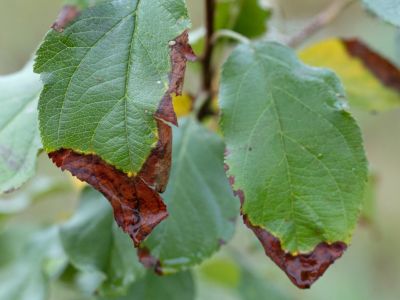Plant Disease: Fire Blight
The plant disease fire blight is oftentimes influenced by seasonal weather and generally attacks the plant’s blossoms, gradually moving to the twigs and then the branches. Fire blight gets its name from the burnt appearance of affected blossoms and twigs.
Fire Blight Symptoms
The symptoms of fire blight can appear as soon as trees and shrubs begin their active growth. The first sign of fire blight is a light tan to reddish, watery ooze coming from the infected branch, twig, or trunk cankers. This ooze begins to turn darker after exposure to air, leaving dark streaks on the branches or trunks. Fire blight infections often move into twigs and branches from infected blossoms. The flowers turn brown and wilt and twigs shrivel and blacken, often curling at the ends. In more advanced cases of fire blight infection, cankers begin to form on branches. These discolored oozing patches contain masses of the fire blight bacteria and heavy infections can be fatal.
Fire Blight Remedies
Fire blight bacteria is easily spread through various means such as rain or water splashing, insects and birds, other infected plants, and unclean gardening tools. The maximum risk of exposure to this bacterium is late spring or early summer as it emerges from dormancy. Unfortunately, there is no cure for fire blight, therefore, the best fire blight remedies are regular pruning and removal of any infected stems or branches. It may also help to avoid overhead irrigation, as water splashing is one of the most common ways to spread the infection. Special attention should also be given to garden tools, especially those that have been exposed to the bacteria. Tools should be sterilized in an alcohol solution containing three parts denatured alcohol to one part water. Ethanol and denatured alcohol are very different. While ethanol alcohol is not poisonous and quite safe to use, denatured alcohol is a toxic solvent oftentimes used as Shellac thinner. Diluted household bleach (one part bleach to nine parts water) can also be used. Always make sure to thoroughly dry tools to prevent corrosion. It sometimes helps to oil them down as well.
Fire Blight Treatment
Since there are no curing fire blight remedies, fire blight is very difficult to control; however, one fire blight treatment to reduce it is by spraying. A variety of bactericides have been developed to combat fire blight, although chemicals to treat fire blight may not always be effective. For instance, fixed copper products are often used as a fire blight treatment but this only reduces the bacteria’s ability to survive and reproduce. Always read and follow instructions carefully before using any chemicals to treat fire blight. Since chemicals aren’t always effective in fire blight control, organic control, such as extensive pruning, may be the only option for fire blight treatment.
